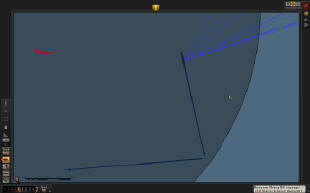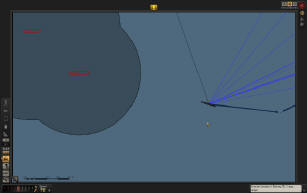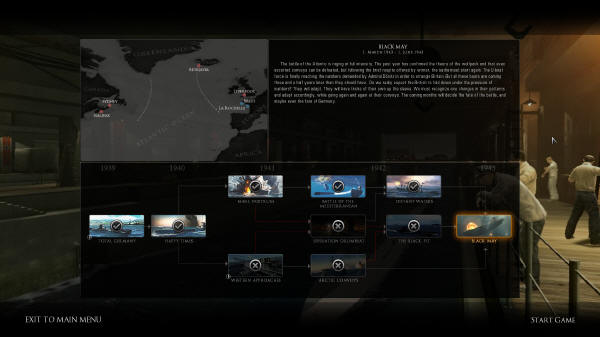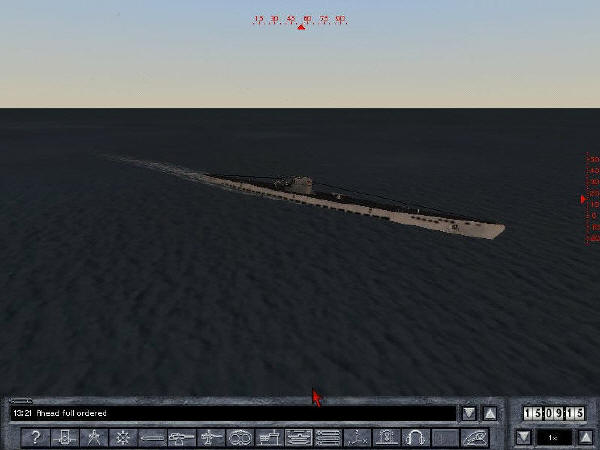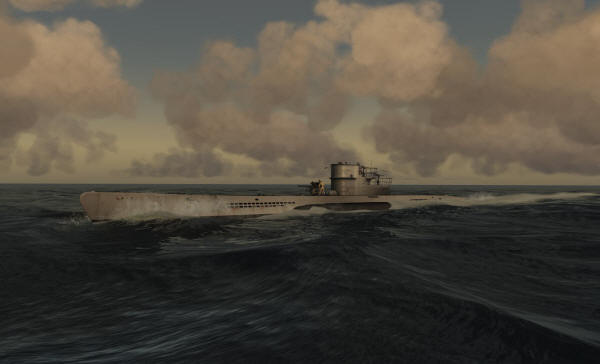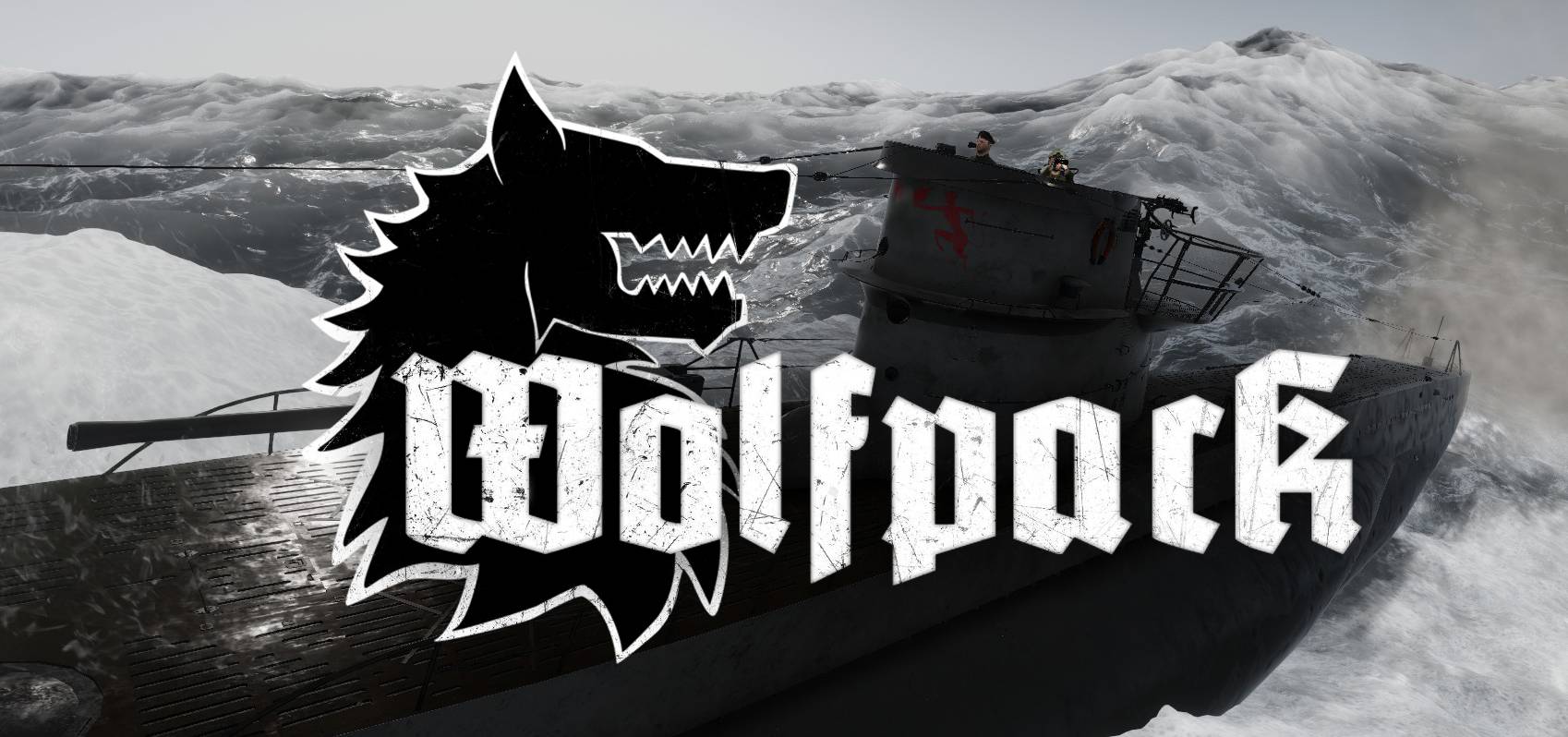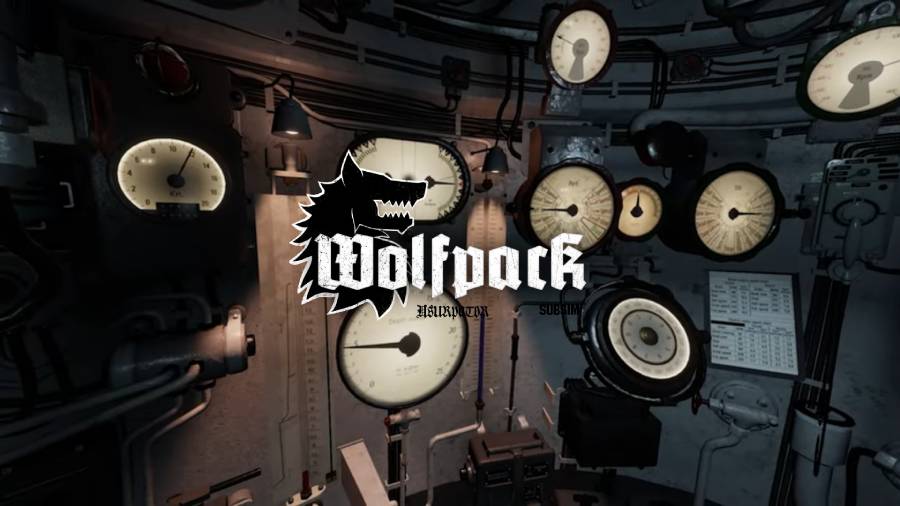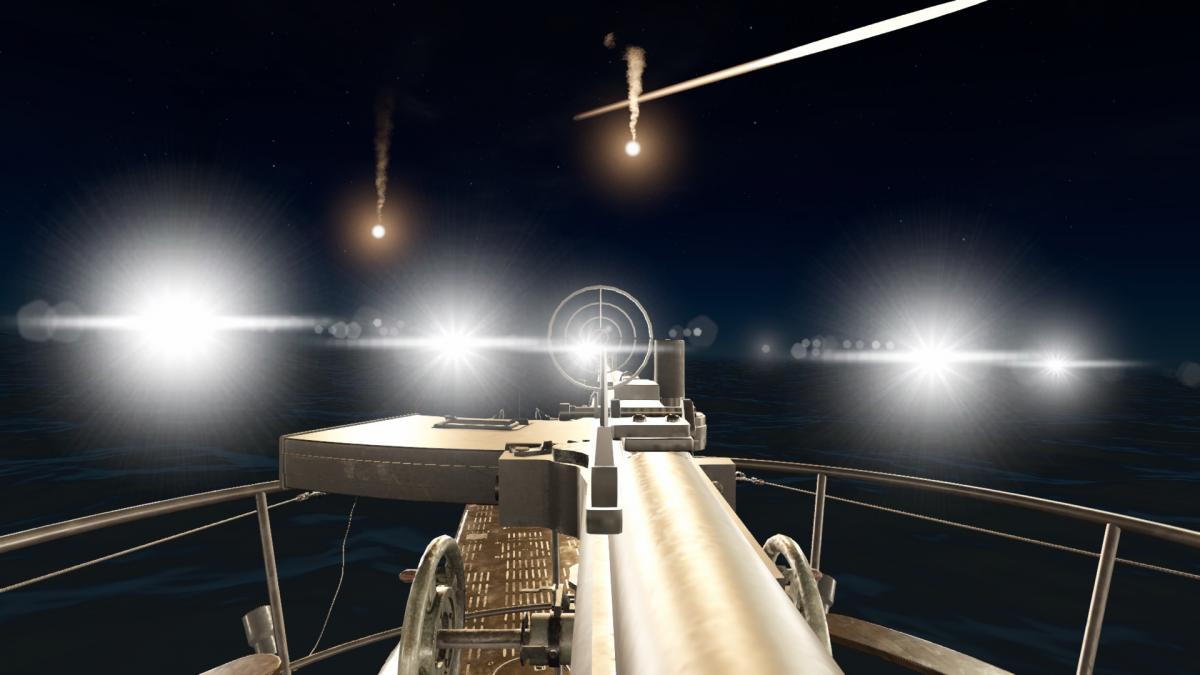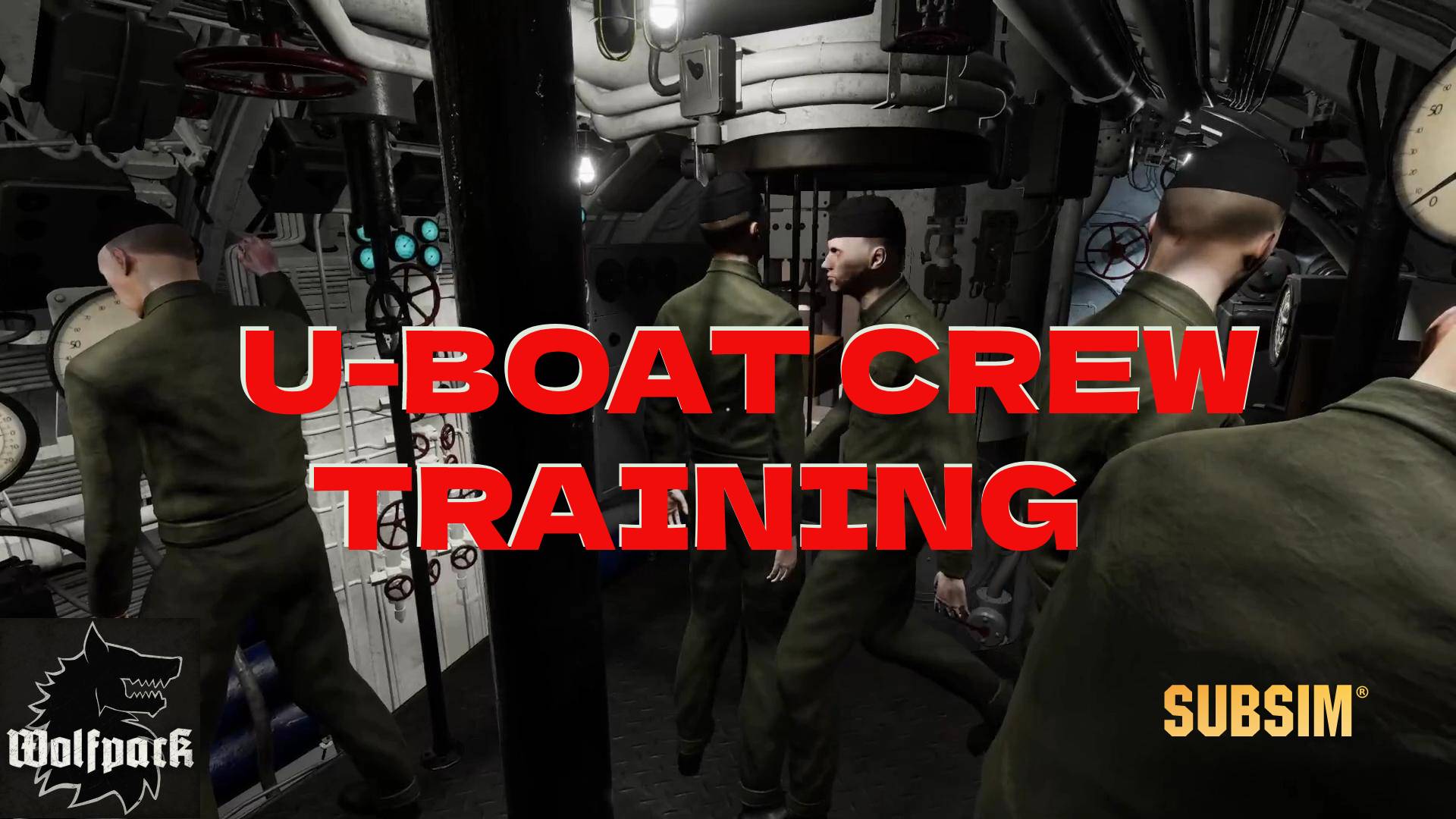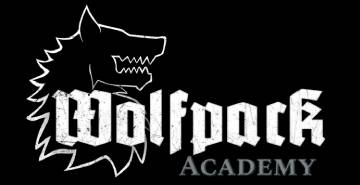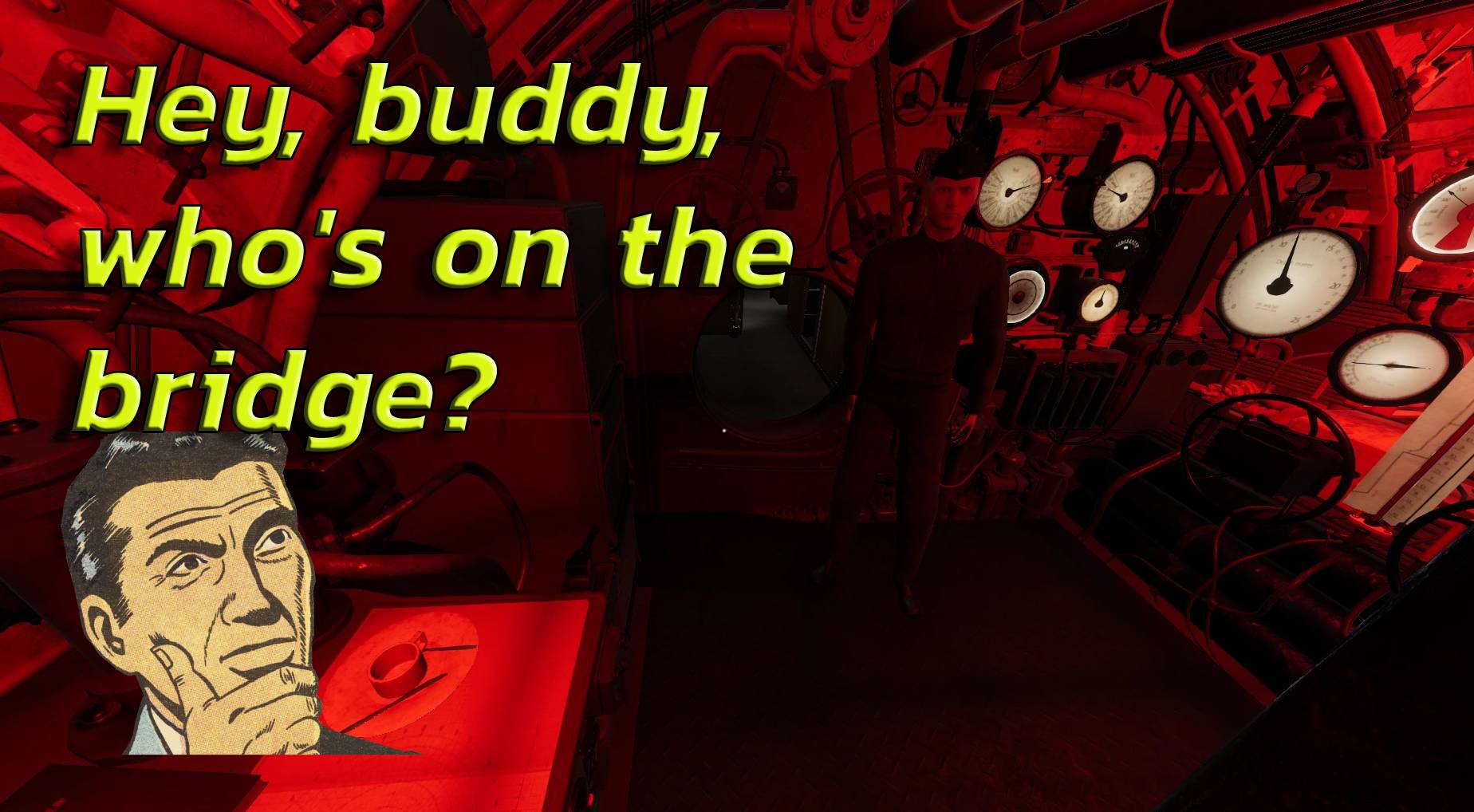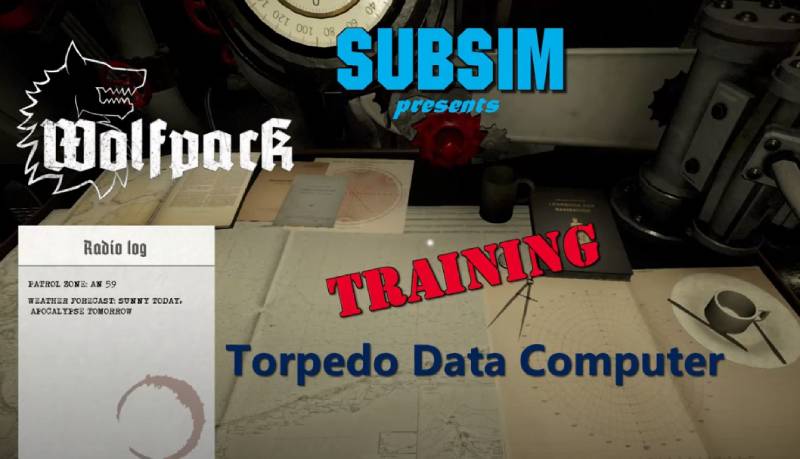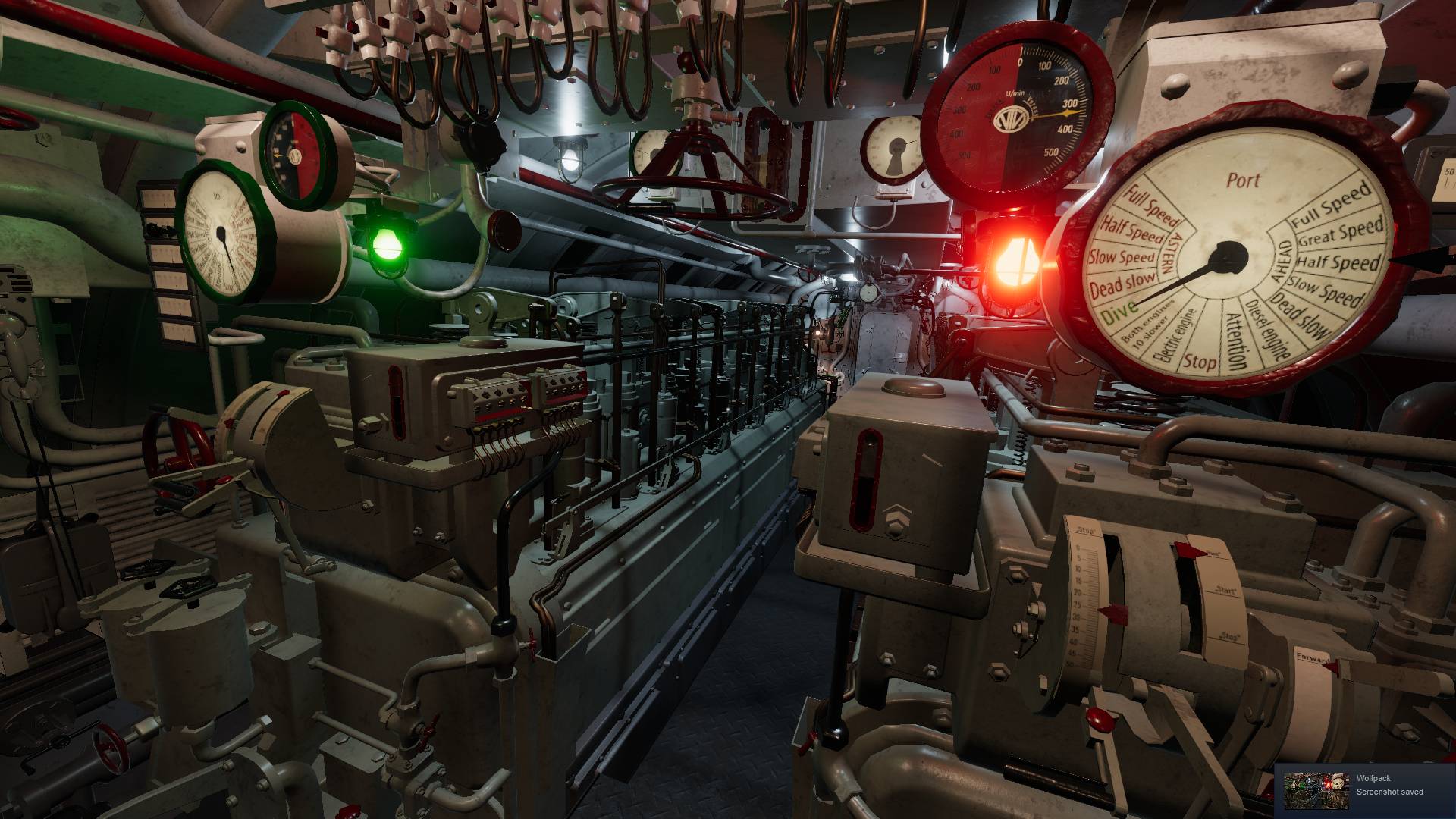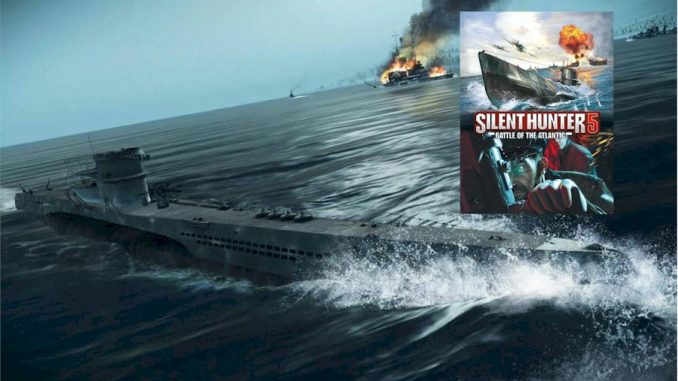
Mar 17, 2010 by Neal Stevens

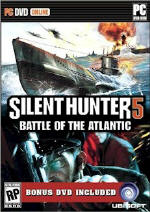 Last year I had the chance to spend four hours aboard the only museum quality Type VII U-boat in the world, U-995 in Laboe, Germany. It was the realization of a dream I had held since I was a boy, to actually walk through a U-boat that had been the home to a German U-boat crew. Life inside a U-boat was a claustrophobic and arduous existence. You’re at sea in a steel pressure hull packed with machinery and weapons and 50 other men but only one toilet, and no shower. There’s little comfort to be had and less privacy. Yet thousands of naval enthusiasts want to recreate that experience and a computer subsim presents one of the best ways to approach it. Many early sub games were rich with tactical gameplay but presented the interior of the sub to the player as 2D “station screens”. Silent Hunter III took a huge step forward with a 3D control room and interactive crew members, though the player was rooted to one spot and limited to a few other compartments–the bridge, the radio room, and the conning tower. And moving from one part of the boat to another was instantaneous–a hot key and zip–you were there. It was better than anything that had come before it yet still could not capture the full essence of life in a submarine.
Last year I had the chance to spend four hours aboard the only museum quality Type VII U-boat in the world, U-995 in Laboe, Germany. It was the realization of a dream I had held since I was a boy, to actually walk through a U-boat that had been the home to a German U-boat crew. Life inside a U-boat was a claustrophobic and arduous existence. You’re at sea in a steel pressure hull packed with machinery and weapons and 50 other men but only one toilet, and no shower. There’s little comfort to be had and less privacy. Yet thousands of naval enthusiasts want to recreate that experience and a computer subsim presents one of the best ways to approach it. Many early sub games were rich with tactical gameplay but presented the interior of the sub to the player as 2D “station screens”. Silent Hunter III took a huge step forward with a 3D control room and interactive crew members, though the player was rooted to one spot and limited to a few other compartments–the bridge, the radio room, and the conning tower. And moving from one part of the boat to another was instantaneous–a hot key and zip–you were there. It was better than anything that had come before it yet still could not capture the full essence of life in a submarine.
This was Ubisoft’s goal for Silent Hunter 5: “Battle of the Atlantic”, to raise the bar again by giving the player a full 3D Type VII U-boat to live and fight in. No more hot keys; now as the captain you can move realistically from the bow torpedo room to the stern e-motor room and all compartments in-between (except the head, and trust me, you don’t want to look in there). The sub interior is nicely detailed, and as I said previously, a real treat.
Between encounters, I would slow the time compression to 1X and go through the compartments one by one and look around, check out the crew. Being able to walk through a virtual U-boat offers an intangible element that only requires a little imagination to open up the game in new ways.
Even though having full boat access adds little to the actual gameplay, there’s always been more to a subsim than just gameplay. A truly great subsim transcends computer game mechanics to stimulate the imagination the way books like Iron Coffins and U977, and films like Das Boot did. Writing about Silent Hunter 5 is a challenge. There’s no way to sugarcoat it, the game has lots of issues and shortcomings, but it does some things well and it’s a lot more fun to play it than write about it. One thing it does magnificently is give the player a very realistic sense of being on a U-boat. Just the simple act of opening the bridge hatch, climbing down the ladder into the conning tower, ordering dive, and watching the attack scope rotate into position is one of the quiet strengths of Silent Hunter 5 that should not be overlooked.
 In addition to the full boat access, the other main thrust of SH5 is the interactive crew and roleplay elements Ubisoft created to further establish the U-boat life. Your crew are stationed throughout the boat, engaged in their tasks or trying to get some rest while off watch. Your interaction with them is very limited: you can give one or two orders to each key crewman, such as “Man the deckgun” or ordering battlestations. You can also exchange small talk or show interest in some of the crew’s lives, but again, this is so restricted and the characters’ emotional palettes are so narrow, that it’s the least interesting part of the game. You may ask the Watch Officer, Dieter, what he thinks of the new XO and he will reply with a wisecrack. And that’s it. For the rest of the patrol (and several after), you will see a cartoon speech balloon appear over Dieter’s head, suggesting he has something to say, but he’s just going to repeat the same joke. I can see where, with a database of several hundred lines of dialogue, this could have been a fantastic addition to the game but as it stands, it’s like having a radio that only plays one short song. There’s some kind of story as you progress, but I did not find it interesting.
In addition to the full boat access, the other main thrust of SH5 is the interactive crew and roleplay elements Ubisoft created to further establish the U-boat life. Your crew are stationed throughout the boat, engaged in their tasks or trying to get some rest while off watch. Your interaction with them is very limited: you can give one or two orders to each key crewman, such as “Man the deckgun” or ordering battlestations. You can also exchange small talk or show interest in some of the crew’s lives, but again, this is so restricted and the characters’ emotional palettes are so narrow, that it’s the least interesting part of the game. You may ask the Watch Officer, Dieter, what he thinks of the new XO and he will reply with a wisecrack. And that’s it. For the rest of the patrol (and several after), you will see a cartoon speech balloon appear over Dieter’s head, suggesting he has something to say, but he’s just going to repeat the same joke. I can see where, with a database of several hundred lines of dialogue, this could have been a fantastic addition to the game but as it stands, it’s like having a radio that only plays one short song. There’s some kind of story as you progress, but I did not find it interesting.
It’s even more annoying when you order the torpedo petty officer to pre-heat the electric torpedoes before an attack, to have him say, “Cannot comply”. Wait, this is a naval vessel, come again? You see, in order to get more performance from your men, you have to earn skill points by sinking ships and completing objectives (more on objectives later). In addition to skill points, there is morale to manage. From the manual:
When out at sea for long periods, sailors become increasingly tired. As a result, their morale will gradually decline. Officers and petty officers will use their “morale pool” as the main resource for activating their special abilities. Morale is regained each time an enemy ship is sunk, or an objective completed.
Your success allows you to dole out a few promotion points to your crew each patrol, raising their abilities to pre-heat torpedoes, unveil hidden enemies on sonar, make tasty soup, and other quasi-realistic talents. This clumsy attempt to inject some character leveling into the game was better served by SH3’s system of awarding promotions and medals, and providing the crew with better capabilities in a broader, less specific sense.
The crew renderings are good quality but their actions are poorly executed. The trailer that introduced the game was startling–music playing on the gramophone, men moving through the boat, speaking to the captain, depth charges rocking the sub, throwing men to the deck. If this was the next Silent Hunter, we thought, sign us up and issue our oilskins. Alas, in the actual game, the crew ambience is a big departure from the initial game trailer. They lay around lethargically rubbing their heads, looking sick and sullen, mute and oppressed, or standing like statues in the forward torpedo room. The crew don’t go up or down the ladders and they don’t rush forward during crash dives. When they speak with the captain, they often look in the wrong direction, or spin around. And there is no music. No wonder morale is so important in the game.
 It’s apparent that Ubisoft meant to broaden the appeal and accessibility of SH5 to capture new market segments, which I applaud as long as the game remains scalable for hardcore realism simulation players, but I have to question how they went about it. The intro to the campaign serves as a tutorial, and begins with a compelling storyline. As a tutorial it is inadequate; the player gets a few tips on using the mouse and time compression, and is tasked with raising the scope and sinking a couple of target ships. Then he returns to Kiel and the guessing game begins. How do you get new mission orders? How do you refit your sub? How does the TDC work? This is a step back from the four mini-missions in SH4, and that’s really saying something.
It’s apparent that Ubisoft meant to broaden the appeal and accessibility of SH5 to capture new market segments, which I applaud as long as the game remains scalable for hardcore realism simulation players, but I have to question how they went about it. The intro to the campaign serves as a tutorial, and begins with a compelling storyline. As a tutorial it is inadequate; the player gets a few tips on using the mouse and time compression, and is tasked with raising the scope and sinking a couple of target ships. Then he returns to Kiel and the guessing game begins. How do you get new mission orders? How do you refit your sub? How does the TDC work? This is a step back from the four mini-missions in SH4, and that’s really saying something.
The game manual is no longer printed (US versions) but still quite awful and sparse. It spends a mere 1/2-page about torpedoes and targeting, nothing about the TDC, but six pages of cheesy crew profiles. It’s galling that a simulation cannot come with better information about the game and how to play it, let alone tactics and historical background, when the manual is not even printed. Why can’t the developers assign someone to write out simply how the game works? What are the yellow and red disks around ship icons in the tactical map? What are those lines coming from you sub when you are submerged? Why are some black and some blue? How do you steer the boat? An experienced player who cut his teeth on Aces of the Deep in the ’90’s can figure it out, but what about some high school kid who bought SH5 as his first subsim? Here’s what the manual says about the tactical map:
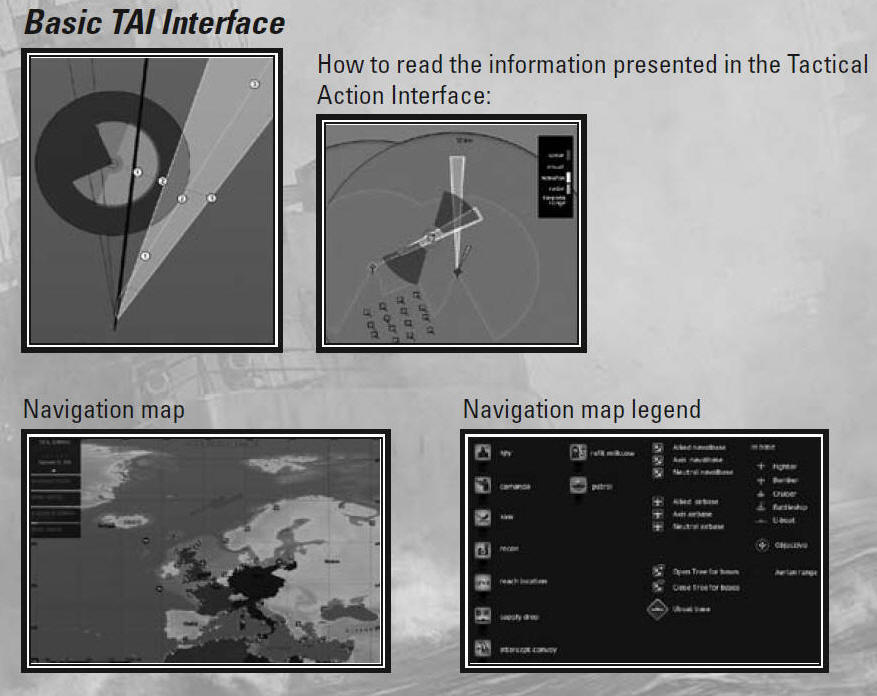
Printing “How to read the information” is not the same as explaining what these illustrations mean, and how to interpret them in the game. I zoomed in to 400% on the pdf page and was unable to make out the blurry Navigation map legend–obviously these symbols and captions mean something but what, I have no idea if I cannot read them. If they expect new market segments to get into the game, a good manual and a good set of tutorial missions are essential, and in this department, Silent Hunter 5 dives with all hatches open. The pdf manual is a mere 31 pages, and if you kick out the fluff and padding, you have approximately 20 pages of information about the game, most of it very general. Remove the images and you’re left with six pages of text, about the same length as this review. There’s just no excuse for this.
New players will grapple with the game using an interface that is modernized and no longer mimics the gritty 1940’s-era look and feel that players have come to expect. There is no direct helm command other than changing the waypoints in the chart (the waypoint system is pretty good, though). This has been improved through mods but again, what were they thinking? In a real U-boat, a captain just said, “Make course 255”, and it was done. How is not having a compass dial more realistic?
One area where SH5 stays true to its roots is the simulation aspect. The game strives to be as realistic and historically accurate as its predecessors and generally achieves this goal. You have the usual options from SH3/SH4 including the important “no map contact updates” which allows you to plot tacticals on the chart without unrealistic, real-time ship icons. Making an encore appearance from SH3/SH4 is “Realistic sensors” and “Manual targeting system”. SH5 also adds a couple options–“ship health meters” and “deck gun projectile path”, intended for new and casual players who prefer more information than a real U-boat skipper could have dreamed of.
The level of detail Ubisoft built into the simulation can be seen when playing with map contacts “on”, and you notice that the circle of visibility around each AI ship changes depending on the position of your sub to the ship. If you are beam on, if you are presenting the fill length of your U-boat to the enemy, he can see you at a greater distance. If you are bow or stern on, your much smaller profile makes you harder to see.
With the new and “improved” manual TDC, you perform the same essential steps of identifying the target, determining range, bearing, speed, and angle on the bow to work up a manual solution. The TDC operation is less elegant than before, the prompts you need to click are smaller and they require precision to “click” them. Also, the ship ID book is a feckless ghost of past ID books–it’s tiny, has only broadside profiles, and no info about mast heights or draft. I did find that the TDC allows memory settings of previously marked ships, so you can mark targets, come back to them and the system remembers what you designated. This nice feature allows you to mark several ships, switch targets much more easily and realistically than before.
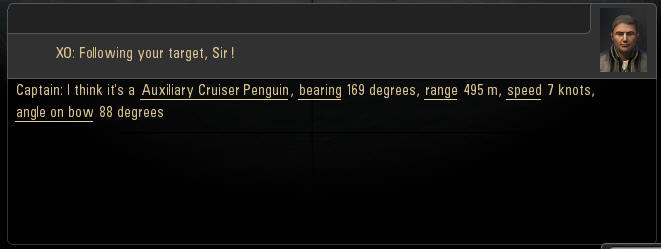
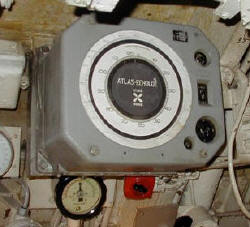 For some reason, the depth beneath the keel function exists in the game but there is no hot key for it. To enable your echolot, you need to check CCIP’s Command Keys mod. It’s pretty important, since the charts do not provide detailed seabed information. The boat’s consumables are represented; battery life and fuel range feel right but the CO2 reaches toxic levels too quickly, it’s difficult to stay submerged more than 14 hours. Changing depth uses compressed air now, and a blast to blow all ballast can use 15-25%.
For some reason, the depth beneath the keel function exists in the game but there is no hot key for it. To enable your echolot, you need to check CCIP’s Command Keys mod. It’s pretty important, since the charts do not provide detailed seabed information. The boat’s consumables are represented; battery life and fuel range feel right but the CO2 reaches toxic levels too quickly, it’s difficult to stay submerged more than 14 hours. Changing depth uses compressed air now, and a blast to blow all ballast can use 15-25%.
While on the topic of mods, one must tip their hat to the dev team for continuing the tradition of leaving the game structure open, and indeed, receptive, to third party mods. Even if Silent Hunter 5 had been delivered relatively bug free and polished, avid subsim skippers love to tinker under the hood. Mods and modmakers play a substantial role in the longevity of the game and Ubisoft has supported this activity. Mods for SH5 are off to a great start.
The SH5 damage modeling is not finished. When you encounter a severe attack, you will get damage reports of “hull damaged”, quickly followed by “hull repaired!”, often many times in succession. Items are usually repaired in a few minutes and other than hull damage, do not seem to make an appreciable impact on your sub’s performance. Your periscope can be damaged to 90%, whatever that means, and you can still use it. Whereas SH4 had localized hull damage modeling, SH5 is back to the one-hull-fits-all style. The flooding animations are over the top. Instead of a valve or a pipe leaking, every fitting in the boat seems to be spraying water. On the positive side, if you take hull damage you might find it difficult to maintain depth. Your boat will get heavier as it takes on water and you will see the U-boat slowly dropping below your ordered depth. If you sustain hull damage, be careful how far down you dive. A boat with 50% hull integrity at 100 meters can suffer sudden catastrophic flooding and that’s not good.
The game comes with seven historically based single missions, which include screening the Bismarck and making a run through Gibraltar. For the first time, the campaign is truly “dynamic”. Each patrol offers nearly unlimited opportunities for chance encounters of aircraft, single ships, convoys with escorts (and occasionally, without), warship task forces, and enemy submarines. A word of information here, this is a review, not a campaign walkthrough, and since the way I play the game takes a lot of time (I can spend 3 hours of real time stalking a convoy and getting into position for an attack), I am writing this article with much of the campaign ahead of me. The war’s timeline is broken into segments that have strategic objectives such as sinking a carrier, or sinking 100,000 tons of merchant shipping, which seems a bit too scripted, since sinking any and every ship you come across was pretty much the baseline objective for every U-boat captain. Thankfully these game objectives are treated like bonuses; you can continue playing even if you do not complete each one. As you progress through the war, you can choose which type of branching campaign you want.
You will find as you play, the actions of the AI is linked to your activity and presence. If you are spotted by aircraft off the coast of England, you should not be surprised if a patrol shows up soon after. In one situation I attacked a convoy, torpedoed two ships, and escaped in the opposite direction the convoy was headed. I waited until they were out of visual range and after a quick periscope sweep, I surfaced and started recharging my batteries. It was about 45 minutes later that two destroyers had ranged out and found me and started shelling me. I reloaded from my last save point and replayed the mission to see if their behavior would be the same if I remained submerged. I saw the two destroyers racing west again, bypassing my submerged position. It was about an hour later a new convoy appeared from the direction the destroyers were last seen; the game gives the impression the destroyers were going out to meet an inbound convoy. Impressive.
Each patrol begins right in the U-boat pen with a wonderful scene of work going on all around you. The harbor is bustling with activity–ships and even a few U-boats going in and out, moored to the piers. This enormously satisfying setting is frequently disrupted by broken ship collision routines. In every harbor, friendly and enemy, there’s usually one or two ships stuck in a ramming mode against a pier or on fire and burning. That really throws a wet rag on the whole atmosphere. With map contacts set to realistic, you have to be your own harbor pilot and manually navigate your boat out of port, which is good addition to the gameplay. There are special missions inside the campaign that include dropping off agents and a recreation of Gunter Prien’s attack on Scapa Flow (which I am happy to report can be accomplished through the narrow eastern inlet, unlike SH3). Enemy harbors are usually well defended and the Channel and Gibraltar are tough nuts to crack.
 Playing with map contacts “on”, all enemy ships are depicted on the map in real time and a player can click on them and get their speed, use the ruler to get their range, and the protractor to get their angle of the bow. The enemy ships show their detection range for ASDIC, hydrophones, and visual depicted on the chart, similar to Aces of the Deep. These are very handy tools for a lot of players. When your U-boat is submerged, traditional sound bearing lines show you the direction of enemy ships. With map contacts “off”, the only thing the map shows is the player’s sub and land. You have the same map tools as before to work up manual solutions.
Playing with map contacts “on”, all enemy ships are depicted on the map in real time and a player can click on them and get their speed, use the ruler to get their range, and the protractor to get their angle of the bow. The enemy ships show their detection range for ASDIC, hydrophones, and visual depicted on the chart, similar to Aces of the Deep. These are very handy tools for a lot of players. When your U-boat is submerged, traditional sound bearing lines show you the direction of enemy ships. With map contacts “off”, the only thing the map shows is the player’s sub and land. You have the same map tools as before to work up manual solutions.
While on the subject of the map, the map contacts have lost functionality from SH3 and you no longer get a contact age or time recorded. With the Map Contacts option “on”, the game automatically ID’s all ship icons as enemy, friend, or neutral. And while no crew member shouts out, “Target destroyed!”, when you torpedo a ship and the game decides it’s fatal, the map instantly displays a sunk ship icon and you can no longer lock the ship, effectively telling you that your job is done. I’m in the group who prefers to wait until the ship sinks beneath the waves to have it classified as “sunk”, so this has not improved over previous games.
Silent Hunter 5 comes with Ubisoft’s new copy protection scheme which requires the game to be played with an online connection all the time. It’s a big problem for people who travel or do not have reliable internet. People can debate whether this is effective or not, whether 200,000 illegal downloads equates to 200,000 lost sales, or merely 10,000 lost sales. I am not going to grab a torch and pitchfork over this, I understand the reason behind a game company protecting their assets. I will say it would make good business sense and customer relations for Ubisoft to come forward with a pledge and a plan to scale back or disable the copy protection at some point in the future. They did this for StarForce in SH3, and with the v1.5 patch in SH4. They probably have a plan for this in SH5, but are reluctant to reveal it at this point.
Radio message traffic is still very generic. BdU does occasionally send reposition orders and contact reports, but I got no traffic from other U-boats. Speaking of other U-boats, as mentioned in the January interview, I have been told that wolfpacks can spawn if you send reports and trail a convoy, but so far I have not seen this. Of all the features players have been hoping for since Silent Hunter III, I cannot think of anything more desired than wolfpacks.
[ad2]
Traversing long stretches of ocean on route to your assigned area can be shorted by using time compression, which goes up to 8192x. There is a travel mode which ignores friendlies and shallow water. One note of concern, with the option Realistic Sensors “on”, I’ve found in almost every patrol where I would be transiting the ocean at 512x, without any warning the submarine would be attacked by an enemy, mortally damaged and sinking, men screaming and crashing, game over–all in about .03 seconds. This meant I had to reload the game from the last save and try again. This is a crippling bug that really hurts the gameplay at 100% realism. And for Pete’s sake, how long have we been asking that any time the time compression is dropped, it be accompanied by some kind of sound effect or crew report?
With the inadequacy of enemy detection at time compression, the save game function is very important. It works for the most part, but there are several bugs. For one, if you save a game while an enemy ship is burning or sinking, when you reload the game, you may see it undamaged while you’re’ still out the torpedoes you expended before the save. And some players are reporting issues with the crew morale not being saved correctly.
One thing is for certain and that is the quality of graphics in SH5 are amazing. The subs and ships look fantastic, with shades and tones that vary with the light, and dynamic shadows that mimic reality. The ocean waves and the foamy edges where the water splashes on the side of your U-boat are gorgeous. This is a treat for the eyes and adds a great deal of pleasure to playing the game. In less than ten years we’ve gone from this:
to this:
The game features a lot of spectacular graphics, like watching the bow break through the waves, which sparkle with realistic foam and motion; a gossamer moon with the stars sinking to the horizon; nearly invisible pinpricks on the horizon that will soon fill your periscope with Royal Navy dread. The concussion effects when you are hit by enemy shells that we saw in SH4 are back. The SH series has always been noted for life-like explosions but I think they overdid it with the pyro in SH5. Ships can be burning from stem to stern with a cascade of explosions that seems a bit too much. There is a variety of weather in the game, from balmy sunshine, fog, rain, and stormy seas.
 Silent Hunter 5 sounds are basically the same as SH3/SH4, in fact, many of the sound files are the exact same. That’s not a knock against SH5, use what works. When you change engine speeds, the pitch and volume change. You track convoys by sound and the hydrophones work pretty well for this. The hydrophone sounds are what you would expect, except your own-sub sounds coming from 180 degrees are either muted or missing. The crew voice acting is sufficient, and in places, very good. The crew will shout and whisper in different situations. I did not hear “depth charges in the water!” but there is “smoke on the horizon”. One thing I expected with the full boat access and crew was much more incidental chatter or sounds. The original orchestra score by Jason Graves is somber and majestic, with a touch of stoic heroism that sounds appropriate for a military subject.
Silent Hunter 5 sounds are basically the same as SH3/SH4, in fact, many of the sound files are the exact same. That’s not a knock against SH5, use what works. When you change engine speeds, the pitch and volume change. You track convoys by sound and the hydrophones work pretty well for this. The hydrophone sounds are what you would expect, except your own-sub sounds coming from 180 degrees are either muted or missing. The crew voice acting is sufficient, and in places, very good. The crew will shout and whisper in different situations. I did not hear “depth charges in the water!” but there is “smoke on the horizon”. One thing I expected with the full boat access and crew was much more incidental chatter or sounds. The original orchestra score by Jason Graves is somber and majestic, with a touch of stoic heroism that sounds appropriate for a military subject.
 The superb graphics never wear off, but once you put some hours into the game, a subsim requires solid gameplay and realistic AI to sustain your interest. I spent a considerable amount of time saving and reloading games to examine how the AI reacts in certain circumstances. SH5 AI is an evolution of SH3/SH4. There are some situations reported where, for some reason only the programmer could explain, a ship will not react realistically to your presence or the odd occurrence like the “stalking AI”, but in most cases, it’s pretty consistent and realistic. As mentioned previously, I have seen some issues with ships acting goofy in harbors, but I would say in the 140 or so hours I have been playing the beta and review builds, the AI of both escorts and merchants is 90% good. Testing with map contacts “on”, I can tell when an escort is in range to detect me, and gauge how they prosecute their attack. I have seen escorts that seem only slightly interested or capable of seeking me out and attacking, and I have seen some pretty aggressive escorts. I think it depends on the period in the war–early on aircraft and escorts don’t threaten me as much as they do later in the war. Oh, and while I’m on the subject of aircraft, Ubisoft Romania is still using generic stand-ins for the US planes, such as a Sunderland for the Liberator. I’m not sure why, they were able to use authentic US planes in RUSE, another Ubi title. This is supposed to be a historically accurate simulation, right?
The superb graphics never wear off, but once you put some hours into the game, a subsim requires solid gameplay and realistic AI to sustain your interest. I spent a considerable amount of time saving and reloading games to examine how the AI reacts in certain circumstances. SH5 AI is an evolution of SH3/SH4. There are some situations reported where, for some reason only the programmer could explain, a ship will not react realistically to your presence or the odd occurrence like the “stalking AI”, but in most cases, it’s pretty consistent and realistic. As mentioned previously, I have seen some issues with ships acting goofy in harbors, but I would say in the 140 or so hours I have been playing the beta and review builds, the AI of both escorts and merchants is 90% good. Testing with map contacts “on”, I can tell when an escort is in range to detect me, and gauge how they prosecute their attack. I have seen escorts that seem only slightly interested or capable of seeking me out and attacking, and I have seen some pretty aggressive escorts. I think it depends on the period in the war–early on aircraft and escorts don’t threaten me as much as they do later in the war. Oh, and while I’m on the subject of aircraft, Ubisoft Romania is still using generic stand-ins for the US planes, such as a Sunderland for the Liberator. I’m not sure why, they were able to use authentic US planes in RUSE, another Ubi title. This is supposed to be a historically accurate simulation, right?
Sometimes the AI is a mystery but that’s good: a German U-boat commander could never predict what Tommy would do or where he would be. On dark nights, once they do see you they will rush over but you will find it fairly easy to dive and evade them. That will change as the war progresses. At long range, enemy escort gunnery is not accurate but if you stay on the surface more than a minute or two they will zero in on you. At close range they can hit you with lethal precision. Merchant ships will zigzag and a convoy will scatter chaotically when they detect you.
In one attack on a convoy I spent a fair amount of time with the scope up, targeting a ship passing before me while another ship passed fairly close behind me (too close to fire). Soon after the ship passed behind me, two DDs charged over from outside the convoy and I had to dive deep. I reloaded the mission to test their behavior and played with very little periscope exposure. As I sat at 40 meters, the merchants passed over me and the escorts did not react until I brought the boat to periscope depth and fired a quick salvo. When the target ship was torpedoed, the destroyers reacted but then they were unable to find me. In some situations I saw one DD sit motionless as the convoy swept by, appearing to be “listening”. After 15 minutes he zoomed off to catch up with the convoy. The AI is not as formidable as far as harbor patrols are concerned. As I approached a enemy harbor I found the escorts will fire on you if they catch you on the surface but once you submerge, they are very likely to resume their patrol when they should be dropping depth charges on your last position.
Once I made contact with a convoy and was fired on and driven off at least 13 times before finally, by luck and desperation, I managed to get in front of the herd of lumbering merchants and sank two cargo ships with a salvo. It’s not unusual for me to leave cripples behind as I chase the convoy. I will mark their position and course with the map tools, chase the convoy to use my remaining torpedoes, then backtrack 200 km to hunt them down and finish them off with the deck gun.
 One area where Silent Hunter 5 shines is the night attack. We’ve all read Werner’s accounts of sneaking into convoys at night with no moon and wreaking havoc. I engaged several convoys under these settings, and with the auto map contacts “off”, the only way I know what’s out there is to look myself. Is that a destroyer closing in among the shadows? I think I see a freighter ahead 15 degrees off starboard bow…but what is his heading? As I close in, always watching around me, my crew calls out sightings. It can get really intense–some merchants have deck guns and know how to use them. If you are detected, ships can pick you out with spotlights. The night vision of escorts varies and with map contacts “off”, it’s hard to really tell when you’re too close or when you’re safe, so you always have to be guessing. When you’re approaching a destroyer in the darkness you can see him but you think he can’t see you because you’re low in the water. But if he gets close enough and detects you, he will attack you with devastating results, and that kind of uncertainty adds tremendous value to the game dynamics making this is the best part of the game; tracking convoys and remaining out of sight and undetected.
One area where Silent Hunter 5 shines is the night attack. We’ve all read Werner’s accounts of sneaking into convoys at night with no moon and wreaking havoc. I engaged several convoys under these settings, and with the auto map contacts “off”, the only way I know what’s out there is to look myself. Is that a destroyer closing in among the shadows? I think I see a freighter ahead 15 degrees off starboard bow…but what is his heading? As I close in, always watching around me, my crew calls out sightings. It can get really intense–some merchants have deck guns and know how to use them. If you are detected, ships can pick you out with spotlights. The night vision of escorts varies and with map contacts “off”, it’s hard to really tell when you’re too close or when you’re safe, so you always have to be guessing. When you’re approaching a destroyer in the darkness you can see him but you think he can’t see you because you’re low in the water. But if he gets close enough and detects you, he will attack you with devastating results, and that kind of uncertainty adds tremendous value to the game dynamics making this is the best part of the game; tracking convoys and remaining out of sight and undetected.
SH5 also has a multiplayer client to allow you to form wolfpacks with your friends and attack AI convoys. I tested it and it works very well–no lag or drops. Imagine how sweet it would be if SH5 sold well enough for Ubisoft to add a playable destroyer expansion. There is also an improved mission editor; it is not in the main game menu but you can access it from the main directory.
Summary
 This is a review and it’s arguably too long, but it’s not a bug list or a walkthrough of every phase of the war. There is a lot of content in the Silent Hunter 5 campaign that will take weeks and months to play especially at high realism levels. I like the full boat access. I’ve played for hours and hours and I’m not at all tired of it. In fact, when I’m in my U-boat, many years of memories of submarine books and movies slowly surface. I’m happy in my little iron tube with my crew. I’ll circulate aft and check with Willi, watch the restless diesels, then order a dive and head back to sonar to listen to the convoy approaching. I just wish the crew had more to say (without speech balloons); I would love to hear them talking, doing their jobs, providing me with reports.
This is a review and it’s arguably too long, but it’s not a bug list or a walkthrough of every phase of the war. There is a lot of content in the Silent Hunter 5 campaign that will take weeks and months to play especially at high realism levels. I like the full boat access. I’ve played for hours and hours and I’m not at all tired of it. In fact, when I’m in my U-boat, many years of memories of submarine books and movies slowly surface. I’m happy in my little iron tube with my crew. I’ll circulate aft and check with Willi, watch the restless diesels, then order a dive and head back to sonar to listen to the convoy approaching. I just wish the crew had more to say (without speech balloons); I would love to hear them talking, doing their jobs, providing me with reports.
SH5 has broken new ground with the full boat access and amazing graphics, but it’s not the best U-boat sim ever made. That title still belongs to Silent Hunter III. A couple years back I was asked what I thought was the next step for subsims, I said, “compelling radio traffic, complex objectives like shadowing convoys, genuine wolfpack activity, more role-playing with the crew, and full boat access”. SH5 does not deliver on any of these metrics, with the exception of opening up the whole U-boat to the player. It does not allow the player to complete the entire war, nor follow the Type II – Type VII – Type IX – Type XXI career progression that players have come to expect.
I would be remiss if I did not stress that even with the bugs and glitches, even with the unpopular DRM, Silent Hunter 5 is an enjoyable simulation to spend time with. I like the game. If it gets additional support from the developers, this could be a subsimmer’s dream come true. Would I recommend buying SH5? No, you should wait at least 6 to 9 weeks to see if Ubisoft supports the game with patches. I think it is a fair statement to make that Silent Hunter 5 comes up very short in quality and the onus is on Ubisoft to deliver more quality. They are probably waiting to see if you buy it before they patch it; it’s time they patch it before you buy it. If they do, if we see a second patch and a third in the next two or three months, then you should join the war.
A ship is built on land and is launched to sea when complete. Anyone knows that a ship that is launched before it is finished will sink. While finishing this review, I was asked, “What exactly is an unfinished game?” Good question. Maybe that’s one of those things where you know it when you see, like art, and true love. A better question is: What exactly is a finished game? One thing I know, Silent Hunter 5 isn’t one.
Rating: 76
| Realism | Historical Accuracy | Graphics | Sound/ Music |
Game play | Repeat Play | Stability /Bugs |
Multi- play | Mission Editor |
| 18/20 | 8/10 | 10/10 | 8/10 | 17/20 | 9/10 | 1/10 | 5/5 | 5/5 |
| BONUS: – 5 Released too soon, unfinished, poor tutorial, manual | ||||||||
Additional images by ReFaN
 Care to add something or discuss Silent Hunter V? Los!
Care to add something or discuss Silent Hunter V? Los!




